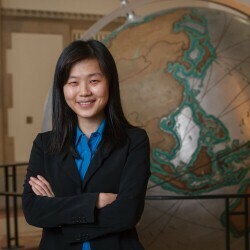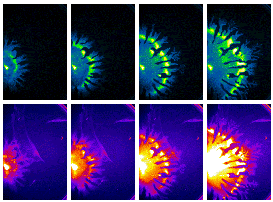

Huijing Du, a Ph.D. candidate in the Department of Applied and Computational Mathematics and Statistics, was first author on a paper published in the Biophysical Journal in August. The article, “High density waves of the bacterium Pseudomonas aeruginosa in propagating swarms result in efficient colonization of surfaces,” reports how a bacterium, Pseudomonas aeruginosa, alters its environment as it swarms to colonize surfaces and form biofilms that help it resist antibiotics.

P. aeruginosa is responsible for acute infections such as those suffered by burn victims and persistent infections such as those associated with cystic fibrosis. The researchers demonstrated that P. aeruginosa efficiently colonizes surfaces by controlling the physical forces responsible for expansion of thin liquid film and by propagating towards the tendril tips. Such greater understanding of biofilm assembly could lead to more effective treatment of the infections.
The article was coauthored by Zhiliang Xu, Oleg Kim and Mark Alber of the department, Matthew Leevy of the Department of Chemistry and Biochemistry and the Notre Dame Integrated Imaging Facility, and Morgen Anyan and Joshua Shrout of the Department of Civil and Engineering and Earth Sciences. Xu and Alber are Du’s advisors. She joined the graduate program in 2008.
The full version of Du's paper is available on the Biophysical Journal website.
In the image on the right: Pseudomonas aeruginosa swarming and RL concentration over time. Swarms on soft agar form tendrils when high concentrations ofRL are present (snapshots taken from Movie S1). Both P. aeruginosa cell density (blue-green) and RL (red-fire) concentrations distribute as a wave (white) through the developing swarm. Images at
6-h intervals (from 12 to 30 h) are presented (Scale bar ¼ 15 mm).